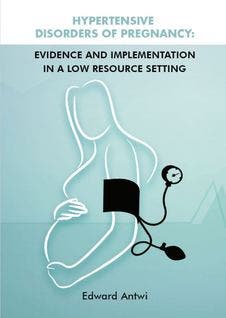Edward Antwi
Hypertensive disorders of pregnancy: evidence and implementation in a low resource setting

- Datum
- (Co) promotoren
- 04-04-2019
- prof.dr. D.E. Grobbee, prof.dr. K.A. Koram, dr. K. Klipstein-Grobusch, dr. I. Agyepong
Samenvatting
Hypertensive disorders of pregnancy are important causes of maternal morbidity and mortality. This thesis describes the nature of hypertensive disorders of pregnancy in Ghana, a low-and-middle-income country (LMIC), and provides evidence on the use of prediction models for early identification of pregnant women at risk of the hypertensive disorders of pregnancy. We estimated the incidence of pregnancy induced hypertension (PIH)across districts in the highly urbanized Greater Accra region and the predominantly rural Upper West region of Ghana, using routine hospital data. The quality of the health management information system (HMIS) data was also assessed. Key variables for routine assessment of PIH such as blood pressure at antenatal visits, weight and height were observed to be 95% to 100% complete. The incidence of PIH differed significantly between the Greater Accra region and Upper West regions. Prevalence of obesity among pregnant women in Greater Accra region was significantly higher than that of women in Upper West region. We recommend an improvement in the quality of routine data to track maternal health indicators. A systematic review of prediction models for gestational hypertension and preeclampsia was conducted with the aim of assessing the methodological quality of the prediction modeling studies and to find prediction models that can be applied in LMIC. Seventy percent of the prediction models reviewed combined biomarkers with maternal clinical characteristics. Of the thirty-two prediction models reviewed, only three had been developed in a LMIC. The use of biomarkers, though enhancing performance of prediction models, may limit the applicability of prediction models in most LMIC because these biomarkers are currently not routinely measured in these settings. Research to develop affordable, easy-to-use uterine artery Doppler imaging equipment and diagnostic assays for serum biomarkers is recommended so the prediction models can be used in low and middle income countries to improve maternal health. We developed and validated a prediction model for gestational hypertension using maternal clinical characteristics obtained at the antenatal clinic visit. The c-statistic was 0.70 and 0.68 for the development and validation cohorts respectively. We also assessed whether adding the biomarkers Pregnancy Associated Plasma Protein-A (PAPP-A) and Placental Growth Factor (PlGF) to maternal clinical characteristics improved the prediction of a previously developed model for gestational hypertension in a cohort of Ghanaian pregnant women.The Area Under the Receiver Operating Characteristic Curve (AUC) was used to assess the predictive ability of the models. The area under the curve (AUC) of the model with only maternal clinical characteristics was 0.75 and 0.89 for multiparous and primigravid women respectively and this increased to 0.82 and 0.95 respectively after inclusion of PAPP-A and PlGF. We concluded that adding the biomarkers to maternal characteristics in a prediction model for gestational hypertension improved predictive ability. Finally we discussed the application of the findings of these studies to improving maternal health in LMIC. Research and development of low cost assays for biomarkers should be prioritized to enable the use of prediction models to identify women at risk of hypertensive disorders of pregnancy early and institute appropriate measures for care.
